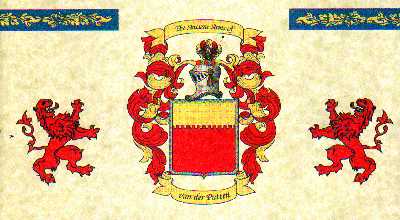

![]()

The Ancient History of the Distinguished Surname van der Putten
The Netherlands has produced many distinguished families including the surname van der Putten. The Netherlands, was occupied by Gallo/Celtic tribes before Caesar's invasion of 57 B. C
Emperor Charlemagne, himself a Netherlander, subdued the Fresians, Franks and Saxons in the 9th century, and compelled them to embrace Christianity. Fresian history records Dirk (Diedric) I about 922. Dirk II founded the Abbey of Egmont. Count Dirk III of Fresia, a favorite of Otto III, expanded from Zuider Zee south to Nijmwegen. This period is considered to be the starting point of the history of Holland. Dirk IV occupied Zeeland in 1047 but was defeated by the Archbishop of Cologne in 1049.
The first mention of Holland, a district surrounding Dordrecht, was in a gift brief dated May 2 1064. Following was a line of Counts Floris I to V of Frisia.
Feudalism had emerged as a system of defense against the Scandinavian invaders of the 9th and 10th centuries. In the 14th century all of the area fell to the house of Burgundy. It was in this region that the surname van der Putten is first found in Holland, where the name became noted for its many branches in the region, each house acquiring a status and influence which was envied by the princes of the region. The name was first recorded in Gelderland, (Guelders) an ancient province surrounding the town of Gelder. To the south of Friesland this province was originally in two parts north and south of the Rhine. In addition, the province is sub-divided into four towns, or quarters, Nijmegan, Arnhem, Zutphen and Roermond, each having unique rights and customs. Apeldoorn is a city of note. In their later history the surnamed became a power unto themselves and were elevated to the ranks of nobility as they grew into this most influential family.
Throughout history most surnames have gone through changes in spelling, even between one generation and the next. Often a name was recorded by a scribe simply by its sound. Depending on the region, a name's spelling may vary quite considerably. Among such variations of the name are Putten, Puttene, Puttenes, Puttens, Puten, Putenes, Putens, Puttenn, Puttenns, van Putten, van der Putten, Putton, Puttan, to name a few examples.
The Hapsburgs gained the Netherlands from the Dukes of Burgundy in 1482, and married into the Spanish royal family. At this time, in the 13th century, the Netherlands included the communes of Flanders, Ghent, Bruge and Ypres and in Brabant those of Antwerp, Louvain, Brussels, and Mechlin, and to the south Hainault, Namur and Cambrai. Meanwhile, to the north Dordrecht, Leyden, Haarlem Detft, Vlarrdigen, flourished in Holland and Middleburg and Zierikzee in Zeeland. In the bishoprics of Utrecht of Gelderland and Friesland the towns of Utrecht, Groningen, Zutphen, Stavoren and Leeuwarden life followed more slowly. The Burgundians in 1430 intruded to the south when Philip the Bold acquired Brabant, Namur, Luxemburg and Utrecht and strongly influenced the northern 5tates by marriage. Mary, daughter of Charles, Philip's son, managed to secure a form of independence in 1477 with the 'Great Privilege,' but then married into the Hapsburgs, thus initiating a long term of dominance by that influential house.
In 1576 began the erosion of the original consortium of States General. Relationships with the south were aggravated by the excursions of the Sea Beggars from Friesland Protestantism was a growing force and formidable revolts raked the country. Many different sects took part, particularly Calvinism. The States General began to disintegrate. After his success at Brill and Flushing the Prince of Orange as stadtholder called the states of Holland to meet at Dordrecht in 1572. The federation of Holland and Zeeland resulted in the formation of the Union of Utrecht, formed in 1579, and Prince William made Holland his home. William became the bulwark of the Protestant faith in Holland and a growing resistance to Spanish influence, while to the south Belgium formed the political Union of Brussels elected in defense of the Catholic religion. It brought about the union between Utrecht and the seven northern provinces in 15 79. In 1581 Prince William of Orange declared independence from the Spanish king.
Meanwhile the surname van der Putten had become established in Holland where they emerged as a notable family early in the Middle Ages. During these turbulent times there were many changing religious and political allegiances. Branches of the family emerged as family members relocated and established themselves in new locations as they were enlisted into military, political and religious service. They branched into Holland, Prussia, Zwolle, and Dordrecht where they held lands and estates. The family was recorded as entering into the ranks of nobility. They were also recorded as being very active in the church. In the ancient history of this name many distinguished themselves including the Putten family of Guelder.
Many people migrated following the vast international interests of the Dutch West and East Indies of the 16th and 17th centuries and in the 19th century to South Africa and other colonies. The highest density of population in North America has been traced to Pennsylvania, New York (New Amsterdam), Ohio, California, and Illinois, while in Canada Dutch-speaking settlement centered around the province of Saskatchewan and the Prairies. Many settlers were found with the surname van der Putten. Many settlers were recorded from the mid 17th century onward in the great migration from Europe to the New World. Contemporary members of the name van der Putten achieved prominence. Notable personalities of this name have contributed to the society on both sides of the Atlantic.
Research has determined the above Coat of Arms to be the most ancient recorded for the family surname van der Putten.